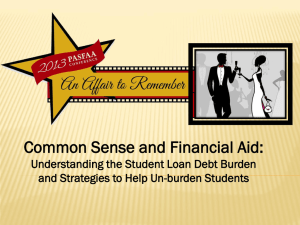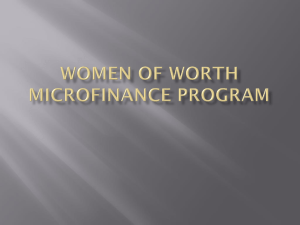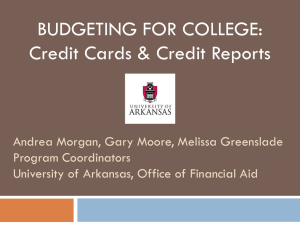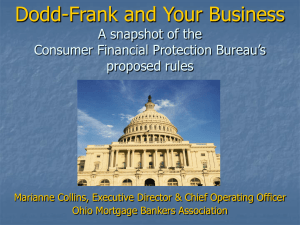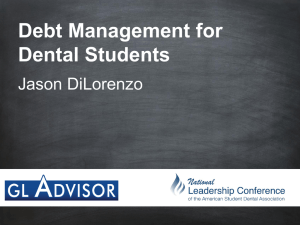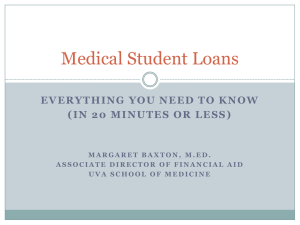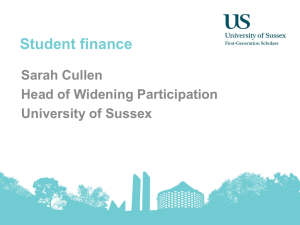Overview Of Repaying Student Loans
advertisement
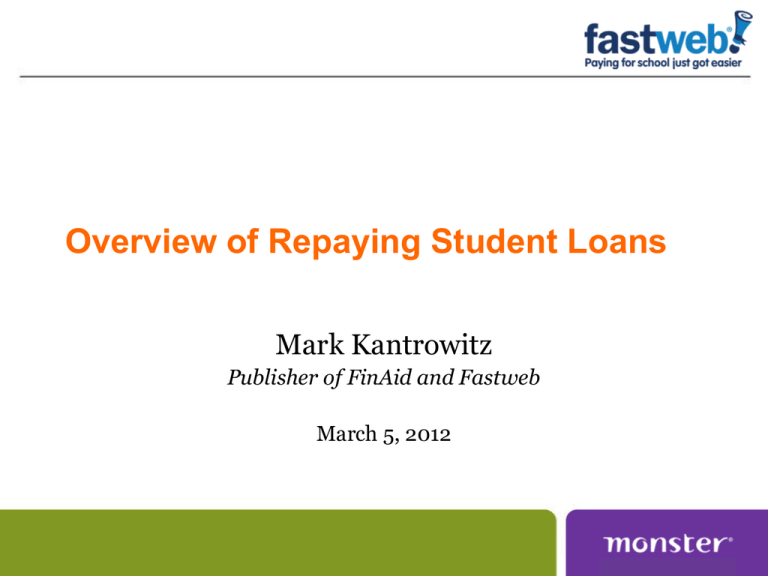
Overview of Repaying Student Loans Mark Kantrowitz Publisher of FinAid and Fastweb March 5, 2012 Get Organized Create a student loan checklist that lists all of your student loans. A blank form is available at www.finaid.org/loans/studentloanchecklist.phtml Put all your paperwork for each loan in its own file folder labeled with the lender name, date borrowed, original loan balance and loan id Notify the lender about any changes in address or contact information Put a note in your calendar at least a week before your first payment is due Lost Your Lender? Talk to the financial aid administrator at your college if you are unsure who currently holds your loans Visit www.finaid.org/loans/lostlender.phtml for links to two services that can help you find your federal education loans • National Student Clearinghouse’s Loan Locator Service • National Student Loan Data System’s Student Access Don’t Miss Payments One quarter to one third of borrowers are late on the very first payment on their student loans • Most student loans have a six month grace period before repayment begins and students often move after graduation, losing track of bills • Borrowers who consolidate their loans are more likely to pay on time, with less than one fifth missing the first payment, probably because the first payment is due soon after consolidation The loan payment is due even if you do not receive a statement or coupon book Set Up Automatic Monthly Payments Set up an automatic direct debit from your checking account to make the monthly payments on your loans Many lenders offer discounts for borrowers who set up auto-debit • Federal loans offer a 0.25% interest rate reduction • Private student loans offer a 0.25% or 0.50% interest rate reduction Borrowers with auto-debit are much less likely to miss a payment Accelerate High Interest Debt First Student loans do not have prepayment penalties After you make the requirement payments, direct any extra money toward accelerating repayment of the most expensive debt first The most expensive debt is the debt with the highest interest rate, not the lowest monthly payment, usually credit cards and private loans Paying an extra $100 on a 10% loan is like earning 10% interest, tax-free, and may save you more than $200 over the life of the loan Student Loan Interest Deduction Up to $2,500 in student loan interest (federal and private) may be deducted each year The deduction is an above-the-line exclusion from income and can be taken even if the borrower doesn’t itemize Only the borrower responsible for making payments can take the deduction Borrower must not be claimed as an exemption on someone else’s tax return The deduction is not subject to AMT Federal Consolidation: Pros Consolidation streamlines repayment by replacing multiple loans with a single loan • The consolidation loan’s interest rate is the weighted average of the interest rates on the individual loans being consolidated, rounded up to nearest 1/8th of a point and capped at 8.25% Consolidation may be used to switch lenders Consolidation provides access to alternate repayment plans which reduce the monthly payment by stretching out the loan term and increasing the total cost of the loan Federal Consolidation: Cons Consolidation generally does not save money You lose the remainder of the grace period You lose favorable benefits on Perkins loans such as subsidized interest and loan forgiveness Some alternate repayment plans are available without consolidation • Extended 25-year repayment is available without consolidating if you have $30,000 or more in debt with a single lender • Income-based repayment is available without consolidation Private Consolidation Private consolidation replaces multiple private student loans with a single loan • Federal and private student loans cannot be consolidated together The new loan has a variable interest rate just like the original loans, but the new rate is based on your current credit score(s) • If your credit score has improved significantly, you might be able to get a better rate Private consolidation may be used to remove the cosigner from the loan (cosigner release) Federal Loan Repayment Plans Standard Repayment (10 year term) Extended Repayment (10 to 30 year term) Income-Based Repayment • Payments based on income, not amount owed • Lower payment than income-contingent repayment and income-sensitive repayment Graduated Repayment • Initially low payments are increased every two years Either income-based or extended repayment yields the lowest payment for most borrowers Extended Repayment Two versions of extended repayment 25-year term without consolidating if more than $30,000 with a single lender Up to 30-year term based on loan balance if loans are consolidated Debt Loan Term Less than $7,500 10 years $7,500 to $9,999 12 years $10,000 to $19,999 15 years $20,000 to $39,999 20 years $40,000 to $59,999 25 years $60,000 or more 30 years Impact of Extended Repayment Loan Term Reduction in Size of Monthly Loan Payment Increase in Total Life-of-Loan Interest Extended Repayment – 12 years 12% 22% (factor of 1.22) Extended Repayment – 15 years 23% 57% (factor of 1.57) Extended Repayment – 20 years 34% 118% (factor of 2.18) Extended Repayment – 25 years 40% 184% (factor of 2.84) Extended Repayment – 30 years 43% 254% (factor of 3.54) Impact of extended repayment on monthly loan payment and total interest paid as compared with standard 10-year repayment Example Repayment Plans Repayment Plan Monthly Loan Payment Total Interest Total Payments Standard – 10 Years $288 $9,524 $34,524 Extended – 12 years $254 $11,639 $36,639 Extended – 15 years $222 $14,946 $39,946 Extended – 20 years $191 $20,802 $45,802 Extended – 25 years $174 $27,054 $52,054 Extended – 30 years $163 $33,674 $58,674 Assumes $25,000 unsubsidized Stafford loan at 6.8% interest and ignores balance-based setting of extended repayment term. Income-Based Repayment (IBR) Loan payments capped at percentage of discretionary income • Discretionary income is defined as AGI minus 150% of the Poverty Line for the family size • Currently 15% of discretionary income, but decreasing to 10% of discretionary income in July 2014 for new borrowers only • $0 payment if income < 150% of the poverty line Remaining debt and interest forgiven after 25 years in repayment (20 years for new borrowers on/after July 2014) Loan Forgiveness Public service loan forgiveness accelerates the forgiveness for income-based repayment to 10 years and makes it tax-free • Only federal student loans are eligible. Parent PLUS loans and private student loans are not eligible. • Borrower must be employed full-time in a public service job, such as police, fire, EMT, government, military, public education, public health, social work, public interest law, public librarians and 501(c)(3) • Will yield a financial benefit if debt exceeds income • Must move loans to the Direct Loan program at loanconsolidation.ed.gov Dealing with Financial Difficulty Use a temporary suspension of loan payments for short-term financial difficulty • Economic Hardship Deferment (3 year limit) • Forbearances (5 year limit) Change repayment plans for longer-term financial difficulty • Income-based repayment reduces the monthly payment based on your discretionary income • Extended repayment reduces the monthly payment by increasing the loan term to 12-30 years All of these options increase the cost of the loan Temporary Suspensions of Payments Difference between deferment and forbearance • Government pays interest on subsidized loans during deferments only • Borrower responsible for interest on unsubsidized loans (deferment) and all loans (forbearance) • Borrower may defer interest by capitalizing it, increasing the amount owed Best for short-term problems, such as medical or maternity leave or unemployment, or as a last resort alternative to default Look into income-based repayment first Debt Grows with Capitalized Interest Forbearance Duration Capitalized Interest Increase in Loan Balance Increase in Lifeof-Loan Interest 3 months $171 1.7% $236 (6.2%) 6 months $345 3.4% $476 (12.5%) 1 year $702 7.0% $967 (25.4%) 3 years $2,256 22.6% $3,115 (81.8%) 6 years $5,021 50.2% $6,933 (182.0%) 9 years $8,409 84.1% $11,613 (304.8%) 12 years $12,562 125.6% $17,348 (455.4%) Increases in loan costs from capitalized interest on a $10,000 Stafford loan with a 6.8% interest rate and a 10-year loan term Dealing with Lenders Keep notes during any telephone call • Ask for the name of the person you talk to • Ask for confirmation numbers for any changes • Ask for written confirmation and call the lender if you don’t get a response within a week Continue paying the loans until you have written confirmation of a deferment or forbearance Send forms by certified mail, return receipt requested Budgeting Tips for High Debt Students Review your spending to identify ways to save money and avoid defaulting on your loans Start with a descriptive budget, where you track and categorize all spending for a month • Distinguish mandatory spending (need) from discretionary spending (want) and compare total mandatory spending with total income • Identify spending on food, clothing, shelter, health, transportation, taxes, student loans, entertainment • Eliminate discretionary spending and substitute lower cost options (e.g., live with parents to save on rent, cut gym membership, sell extra belongings on eBay) Talk to the Lender Before You Default You lose options if you default on your loans • Defaulted borrowers are ineligible for deferments and forbearances There are many options that may help prevent you from getting into default Ignoring the problem will not make it go away; it just digs you into a deeper hole as interest continues to accrue Penalties for Defaulting on Your Loans Garnishment of up to 15% of wages and Social Security benefits Income tax refunds may be intercepted (offset) Collection charges of up to 25% deducted from each payment, slowing repayment trajectory Can’t renew professional licenses The default will prevent you from getting credit cards, auto loans and mortgages and may make it harder to rent an apartment or get a job You will be ineligible for more federal student aid Loan Rehabilitation Rehabilitation is a one-time opportunity to remove a federal student loan default from your credit history and to regain student aid eligibility • Regain eligibility for federal student aid after making 6 consecutive full and voluntary on-time payments • After making 9 of 10 consecutive on-time payments, you can apply to have the loan rehabilitated and the default can be removed from your credit history Call the US Department of Education's Default Resolution Group at 1-800-621-3115 or TTY 1877-825-9923 for more information. Loan Cancellation Closed School Discharge. If the college closed while you were in attendance or up to 90 days after withdrawal Unpaid Refund. If you withdrew and the college owed a refund but never returned the funds to the lender False Certification Discharge. If the college improperly certified your ability to benefit from a higher education or you are the victim of identity theft Death Discharge. If the borrower (or the student for whom a parent borrowed a Parent PLUS loan) dies Total and Permanent Disability Discharge. If a doctor certifies that the borrower is totally and permanently disabled, or if a veteran is unemployable due to a service-connected condition, the federal education loans may be permanently discharged. Bankruptcy Discharge Less than 1% of bankrupt borrowers succeed in getting student loans discharged because of the requirement to demonstrate undue hardship in an adversarial proceeding Undue hardship is a present and future inability to repay the debt and maintain a minimal standard of living even after exhausting options for repayment relief and cutting living costs Discharge is more likely if the financial difficulty was due to circumstances beyond your control Settling Defaulted Student Loans Defaulted federal student loans can be settled for a lump sum payment that is less than the total amount owed • Most settlements include a waiver of the collection charges • Some settlements involve a 10% reduction in the total principal and interest balance • Some settlements involve paying the full principal balance but half the accrued but unpaid interest Get the settlement offer in writing and have an attorney review it Federal Student Aid Ombudsman The FSA ombudsman helps borrowers resolve problems and disputes concerning federal student loans Most lenders and guarantee agencies have their own ombudsman ombudsman.ed.gov 1-877-557-2575 1-202-275-0549 fax fsaombudsmanoffice @ed.gov U.S. Dept. of Education FSA Ombudsman 830 First St., NE, 4th Fl. Washington, DC 202025144 Private Student Loan Ombudsman The PSL ombudsman helps borrowers resolve problems and disputes concerning private student loans • • • • • • Payment problems Confusing advertising Billing disputes Deferment and forbearance Debt collection problems Credit reporting problems www.consumerfinance.gov 1-855-411-CFPB (1-855-411-2372) 1-855-237-2392 fax Consumer Financial Protection Bureau Attn: PSL Ombudsman PO Box 4503 Iowa City, IA 52244 Resources FinAid.org (www.finaid.org/loans) Student Loan Borrower Assistance Project (www.studentloanborrowerassistance.org) Federal Student Loan Consolidation (loanconsolidation.ed.gov) US Department of Education’s Debt Collection Service (www.ed.gov/offices/OSFAP/DCS) FSA Ombudsman (www.ombudsman.ed.gov) PSL Ombudsman (www.consumerfinance.gov)

